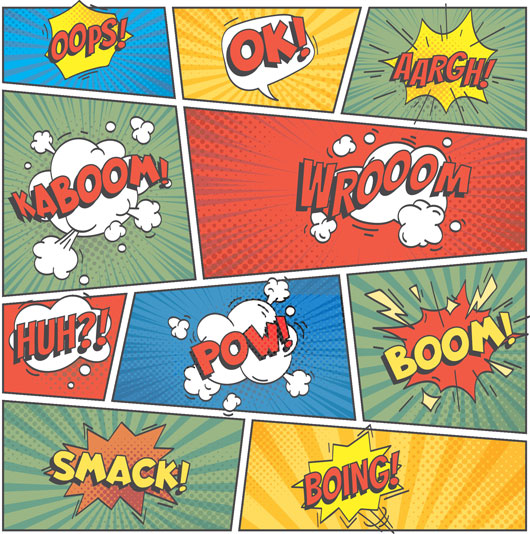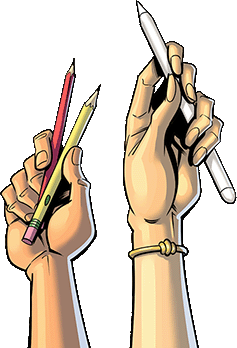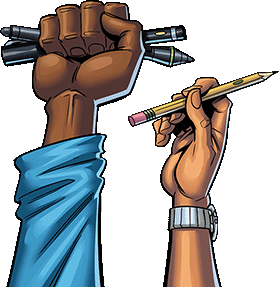What are Some Tips on Making Comic Books?
July 10, 2020
If you're a graphic novel fan, you may have toyed with the idea of creating a comic book. It's a transformative process to bring an idea to life in the form of your own published comic book.
The hardest part of the process may be finding inspiration, although this is only the first of many steps to making a comic book. You’ll also have to write and revise the script, devise the optimal layout, and illustrate the story to see your idea to fruition.
One of the most important parts of the process is choosing the right publisher to guide you, step by step, through the creation process. Here are some other comic book writing tips to keep in mind on the way to your finished product.
Get an Idea
Writing a comic is a form of visual storytelling. A comic book script needs to rely heavily on visual images, and those visual images all need to come from an initial idea.
Plucking an idea for a great comic out of thin air is difficult, and these bolts of genius don't happen often. If you get a great story idea for an excellent comic, jot it down before you forget it.
That's just the first part of writing a good comic. Getting that inkling of an idea onto a comic book page takes a lot of hard work.
You’ll need to shape your idea until it is a well-rounded, fascinating concept. Spider-man didn't just pop out of Stan Lee's head fully formed; it took time and dedication to bring the web-slinger to life.
Once you’ve mapped out the major plot points, you're ready to write your idea down in script form.
Learn How to Write a Script
Scriptwriting will serve you well as a graphic novelist, and it can also help you if you ever wanted to try your hand at screenwriting.
Graphic novels are most commonly created in script form first. Your script doesn't have to be anything fancy, but this format will make it easier to turn your ideas into images.
To write a compelling script, keep in mind four key elements: genre, conflict, setting, and plot.
The genre of your graphic novel can help determine the theme and aesthetic of the piece. A Gothic work will be much darker, or even drawn in only black and white, than other comics.
The conflict is what drives your plot forward. It's whatever is standing in the way of the protagonist reaching their dreams. Characters can conflict with themselves, with other characters, or with nature.
You don't have to spell out your conflict in the first few pages; you can unveil it by using literary devices such as foreshadowing. However, you, as the author, need to have your main character's conflict firmly in mind.
The setting is your story world and all the rules that govern it. Set your story in a world that has physical parameters. Even if this world is based on fantasy, make sure that you, as the author, understand what can and can't happen in your story world.
Finally, ensure your story has a proper beginning, middle, and end. Even avant-garde graphic novels should conform to a narrative shape to help readers understand the story and avoid getting lost.
Get Used to Revision
All writers rely heavily on revisions to transform their initial thoughts into a polished final draft.
Revise your script yourself, or ask friends or colleagues, and be ready for constructive criticism. You ultimately get to decide what works and what doesn't for your creative project, but consider all that your editors say. A different perspective and attention to detail can create beautiful changes in your story.
When you think you've finally finished revising, revise that sucker one more time.
Know the Difference Between Inking and Coloring
Once you have a polished script to work with, begin the process of laying out your graphic novel and drawing it out.
Work with an established artist to sketch out each page. You’ll often start with the establishing shot, which is usually the start of the story or scene and gives the reader essential details about the setting and characters.
Once you have the basic sketches, you can begin inking and coloring. Inking is when the artist paints each cell according to the coloring decisions you make as a team.
Coloring more generally refers to picking out the hues for every panel in your graphic novel. Your coloring choices should be consistent; you can't have the Hulk show up green in one panel and bright purple in the next.
Important Comic Book Details
Some other minutiae will come up as you continue on your creative journey.
Give some thought to sound effects in your panels. These are the whooshes, bangs, and smashes you often see accompanying action in comic books. They do a lot to make the action come off the page for the reader.
Speech bubbles and how you intonate your character's speech are also important. As you peruse others' work, you'll notice that certain words in each speech bubble are in italics. These italics connote intonation and try to mimic natural speech patterns.
Some authors hand-letter their comics, whereby they write out all the text by hand. Others outsource their lettering needs.

Pick the Right Publisher
Once you have a full layout, including coloring and inking, it's time to choose a publisher. You want an experienced publisher who provides a quick turn-around and lots of options at a great price.
Your publisher can help you make a lot of complicated decisions. Choosing wisely at this stage can make the last part of your creation process go smoothly.
The Last Word
Comix Well Spring is an experienced publisher that can help you decide on coloring options, layout, and other stylistic choices.
Our team can help you create a polished graphic novel from start to finish. It's incredible what you can create when you put your mind to it.


